SLVS915C February 2010 – July 2015 TPS73801
PRODUCTION DATA.
6 Specifications
6.1 Absolute Maximum Ratings
over operating free-air temperature range (unless otherwise noted)(1)| MIN | MAX | UNIT | |||
|---|---|---|---|---|---|
| VIN | Input voltage | IN | –20 | 20 | V |
| OUT | –20 | 20 | V | ||
| Input-to-output differential (2) | –20 | 20 | V | ||
| FB | –7 | 7 | V | ||
| EN | –20 | 20 | V | ||
| tshort | Output short-circuit duration | Indefinite | |||
| TJ | Operating virtual-junction temperature | –40 | 125 | °C | |
| Tstg | Storage temperature | –65 | 150 | °C | |
(1) Stresses beyond those listed under Absolute Maximum Ratings may cause permanent damage to the device. These are stress ratings only, and functional operation of the device at these or any other conditions beyond those indicated under Recommended Operating Conditions is not implied. Exposure to absolute-maximum-rated conditions for extended periods may affect device reliability.
(2) Absolute maximum input-to-output differential voltage cannot be achieved with all combinations of rated IN pin and OUT pin voltages. With the IN pin at 20 V, the OUT pin may not be pulled below 0 V. The total measured voltage from IN to OUT cannot exceed ±20 V.
6.2 ESD Ratings
| VALUE | UNIT | |||
|---|---|---|---|---|
| V(ESD) | Electrostatic discharge | Human body model (HBM), per ANSI/ESDA/JEDEC JS-001, all pins (1) | 2000 | V |
| Charged device model (CDM), per JEDEC specification JESD22-C101, all pins (2) | 1000 | |||
(1) JEDEC document JEP155 states that 500-V HBM allows safe manufacturing with a standard ESD control process.
(2) JEDEC document JEP157 states that 250-V CDM allows safe manufacturing with a standard ESD control process.
6.3 Recommended Operating Conditions
over operating free-air temperature range (unless otherwise noted)| MIN | MAX | UNIT | ||
|---|---|---|---|---|
| VIN | Input voltage range | VOUT + VDO | 20 | V |
| VIH | EN high-level input voltage | 2 | 20 | V |
| VIL | EN low-level input voltage | 0.25 | V | |
| TJ | Recommended operating junction temperature range | –40 | 125 | °C |
6.4 Thermal Information
| THERMAL METRIC (1) | TPS73801 | UNIT | |
|---|---|---|---|
| DCQ (SOT-223) | |||
| 6 PINS | |||
| RθJA | Junction-to-ambient thermal resistance | 50.5 | °C/W |
| RθJC(top) | Junction-to-case (top) thermal resistance | 31.1 | °C/W |
| RθJB | Junction-to-board thermal resistance | 5.1 | °C/W |
| ψJT | Junction-to-top characterization parameter | 1.0 | °C/W |
| ψJB | Junction-to-board characterization parameter | 5.0 | °C/W |
| RθJC(bot) | Junction-to-case (bottom) thermal resistance | — | °C/W |
(1) For more information about traditional and new thermal metrics, see the Semiconductor and IC Package Thermal Metrics application report, SPRA953.
6.5 Electrical Characteristics
Over operating temperature range TJ = –40°C to 125°C (unless otherwise noted)(1)| PARAMETER | TEST CONDITIONS | TJ | MIN | TYP (10) | MAX | UNIT | ||
|---|---|---|---|---|---|---|---|---|
| VIN | Input voltage (2)(3) | 25°C | 2.2 | 1.9 | 20 | V | ||
| VFB | FB pin voltage (2)(4) | TPS73801 | VIN = 2.21 V, ILOAD = 1 mA | 25°C | 1.192 | 1.21 | 1.228 | V |
| VIN = 2.5 V to 20 V, ILOAD = 1 mA to 1.0A |
Full range | 1.174 | 1.21 | 1.246 | ||||
| Line regulation | TPS73801 (2) | ΔVIN = 2.21 V to 20 V, ILOAD = 1 mA |
Full range | 1.5 | 5 | mV | ||
| Load regulation | TPS73801 (2) | VIN = 2.5 V, ΔILOAD = 1 mA to 1.0 A |
25°C | 2 | 8 | mV | ||
| Full range | 18 | |||||||
| VDO | Dropout voltage (3)(6)(5)
VIN = VOUT(NOMINAL) |
ILOAD = 1 mA | 25°C | 0.02 | 0.06 | V | ||
| Full range | 0.10 | |||||||
| ILOAD = 100 mA | 25°C | 0.1 | 0.17 | |||||
| Full range | 0.22 | |||||||
| ILOAD = 500 mA | 25°C | 0.19 | 0.27 | |||||
| Full range | 0.35 | |||||||
| ILOAD = 1.0 A | 25°C | 0.24 | 0.30 | |||||
| Full range | 0.40 | |||||||
| IGND | GND pin current (5)(7)
VIN = VOUT(NOMINAL) + 1 |
ILOAD = 0 mA | Full range | 1 | 1.5 | mA | ||
| ILOAD = 1 mA | Full range | 1.1 | 1.6 | |||||
| ILOAD = 100 mA | Full range | 3.8 | 5.5 | |||||
| ILOAD = 500 mA | Full range | 15 | 25 | |||||
| ILOAD = 1.0 A | Full range | 35 | 80 | |||||
| VN | Output voltage noise | COUT = 10 µF, ILOAD = 1.0 A, BW = 10 Hz to 100 kHz |
25°C | 45 | µVRMS | |||
| IFB | FB pin bias current (2)(8) | 25°C | 3 | 10 | µA | |||
| VEN | Shutdown threshold | VOUT = OFF to ON | Full range | 0.9 | 2 | V | ||
| VOUT = ON to OFF | Full range | 0.25 | 0.75 | |||||
| IEN | EN pin current | VEN = 0 V | 25°C | 0.01 | 1 | µA | ||
| VEN = 20 V | 25°C | 3 | 30 | |||||
| Quiescent current in shutdown | VIN = 6 V, VEN = 0 V | 25°C | 0.01 | 1 | µA | |||
| PSRR | Ripple rejection | VIN – VOUT = 1.5 V (avg), VRIPPLE = 0.5 VP-P, fRIPPLE = 120 Hz, ILOAD = 0.75 A |
25°C | 55 | 63 | dB | ||
| ICL | Current limit | VIN = 7 V, VOUT = 0 V | 25°C | 2 | A | |||
| VIN = VOUT(NOMINAL) + 1 | Full range | 1.6 | ||||||
| IREV | Input reverse leakage current | VIN = –20 V, VOUT = 0 V | Full range | 1 | mA | |||
| IRO | Reverse output current (9) | TPS73801 | VOUT = 1.21 V, VIN < 1.21 V | 25°C | 300 | 600 | µA | |
(1) The TPS73801 regulators are tested and specified under pulse load conditions such that TJ is approximately equal to TA. The TPS73801 is fully tested at TA = 25°C. Performance at –40°C and 125°C is specified by design, characterization, and correlation with statistical process controls.
(2) The TPS73801 is tested and specified for these conditions with the FB pin connected to the OUT pin.
(3) Dropout voltages are limited by the minimum input voltage specification under some output voltage/load conditions.
(4) Operating conditions are limited by maximum junction temperature. The regulated output voltage specification does not apply for all possible combinations of input voltage and output current. When operating at maximum input voltage, the output current range must be limited. When operating at maximum output current, the input voltage range must be limited.
(5) To satisfy requirements for minimum input voltage, the TPS73801 is tested and specified for these conditions with an external resistor divider (two 4.12-kΩ resistors) for an output voltage of 2.4 V. The external resistor divider adds a 300-mA DC load on the output.
(6) Dropout voltage is the minimum input to output voltage differential needed to maintain regulation at a specified output current. In dropout, the output voltage is equal to: VIN – VDROPOUT.
(7) GND pin current is tested with VIN = (VOUT(NOMINAL) + 1 V) and a current source load. The GND pin current decreases at higher input voltages.
(8) FB pin bias current flows into the FB pin.
(9) Reverse output current is tested with the IN pin grounded and the OUT pin forced to the rated output voltage. This current flows into the OUT pin and out the GND pin.
(10) Typical values represent the likely parametric nominal values determined at the time of characterization. Typical values depend on the application and configuration and may vary over time. Typical values are not ensured on production material.
6.6 Typical Characteristics
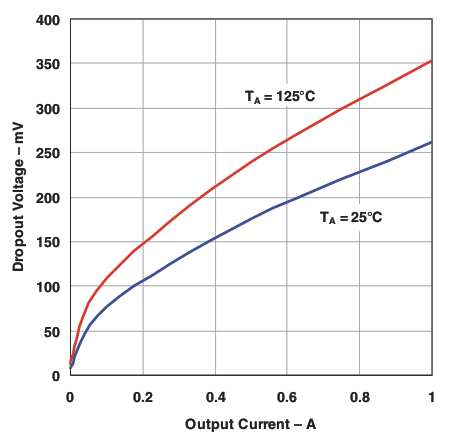
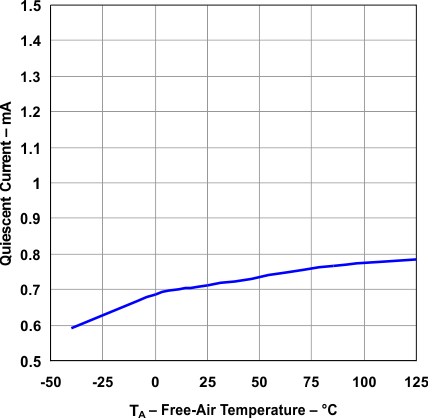
| VIN = 6 V | IOUT = 0 A | TPS73801 |
| VEN = VIN |
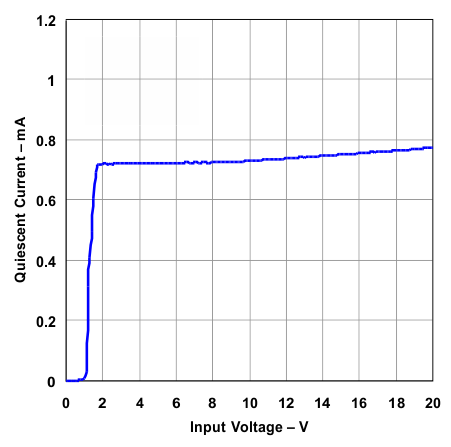
| TJ = 25 °C | ROUT = 4.3 kΩ | TPS73801 |
| VEN = VIN |
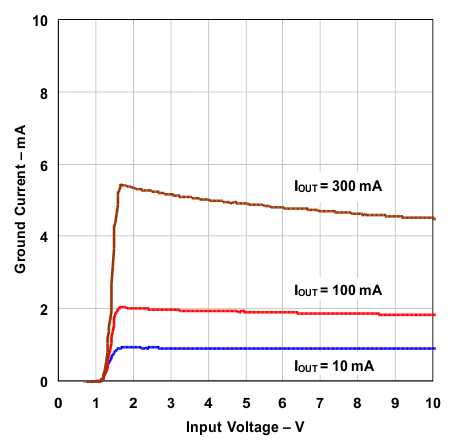
| TJ = 25 °C | VOUT = 1.21 V | TPS73801 |
| VEN = VIN |
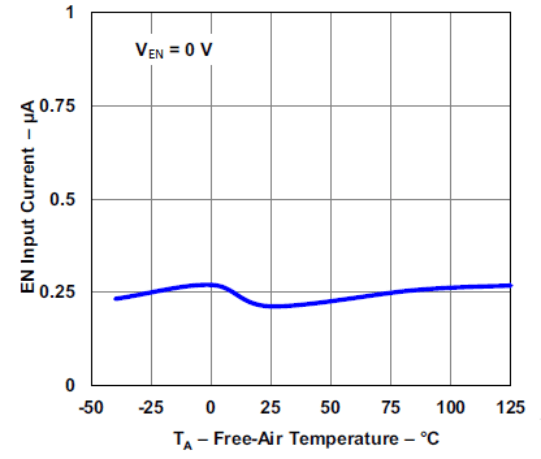
| VEN = 0 V | ||
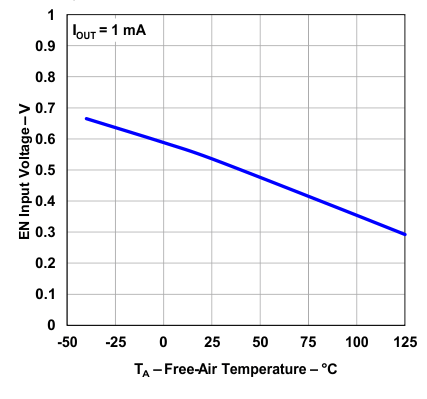
| IOUT = 1 mA | ||
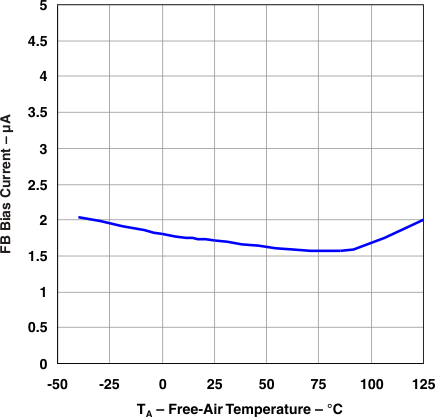
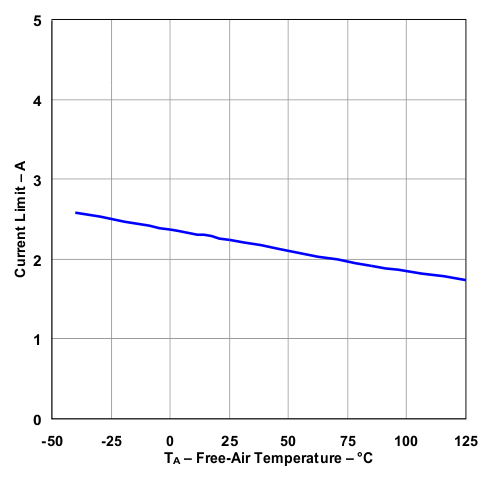
| VIN = 7 V | VOUT = 0 V | |
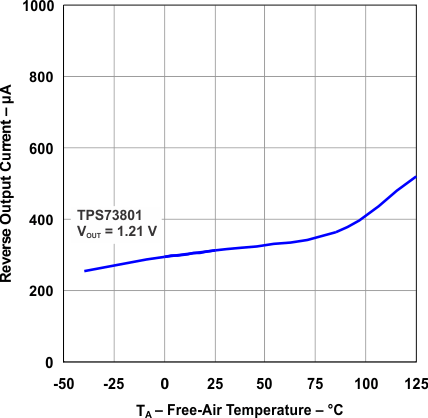
| VIN = 0 V | ||
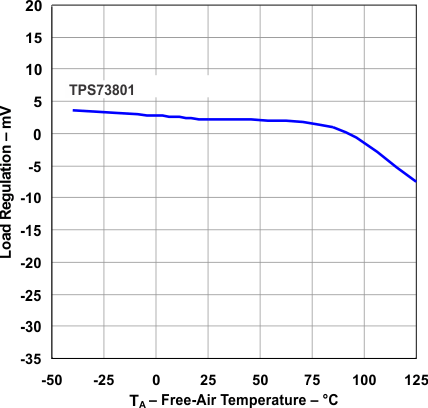
| IOUT = 1 A | ||
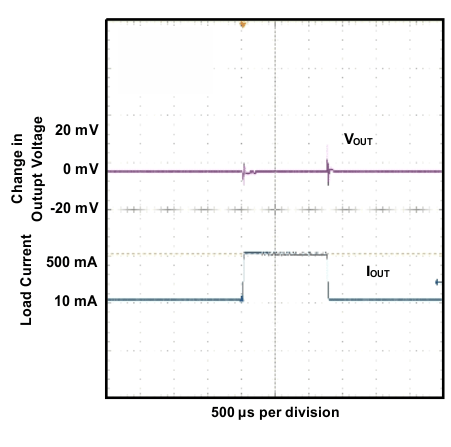
| VIN = 4.3 V | CIN = 10 µF | COUT = 10 µF (ceramic) |
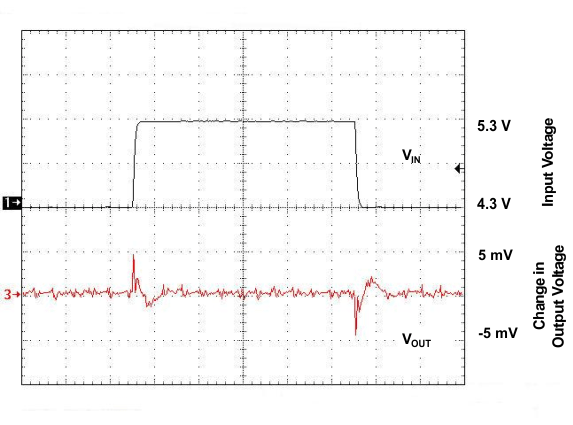
| IOUT = 1.5 A | CIN = 10 µF | |
| COUT = 10 µF (ceramic) | ||
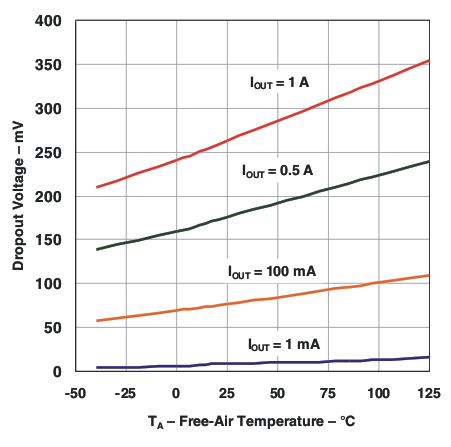
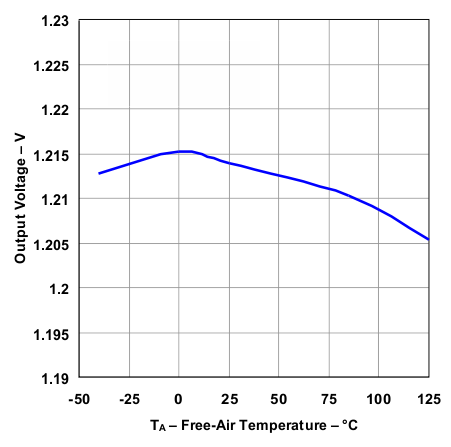
| VIN = 6 V | IOUT = 1 mA | TPS73801 |
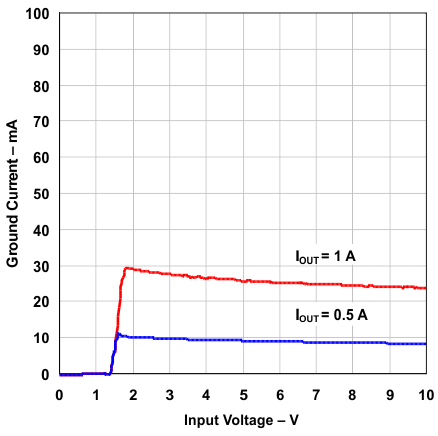
| TJ = 25 °C | VOUT = 1.21 V | TPS73801 |
| VEN = VIN |
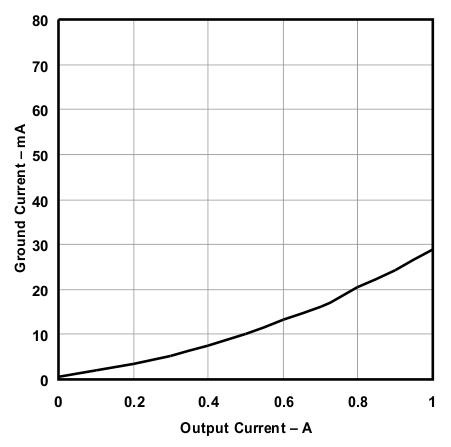
| VIN = VOUT(nom) + 1 | ||
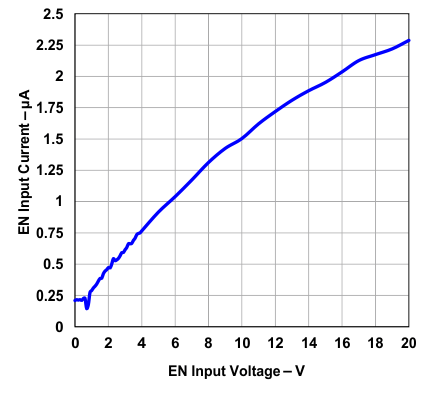
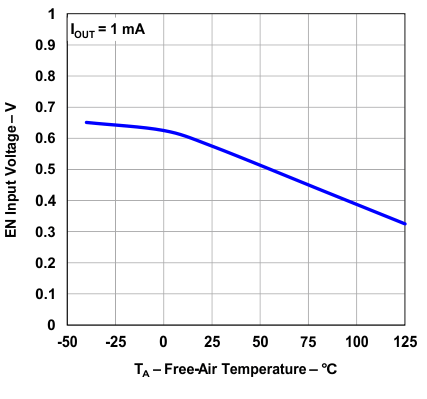
| IOUT = 1 mA | ||
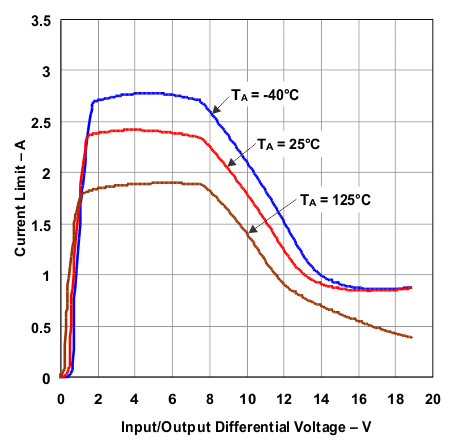
| ΔVOUT = 100 mV | ||
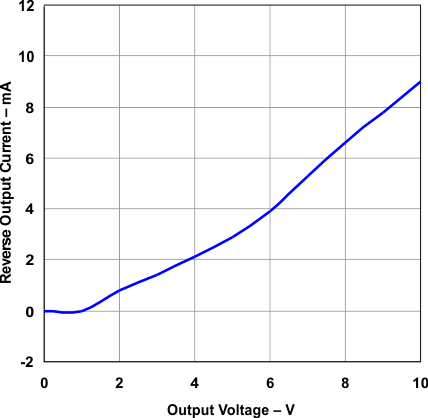
| TJ = 25 °C | VIN = 0 V | |
| Current flows into OUT pin | ||
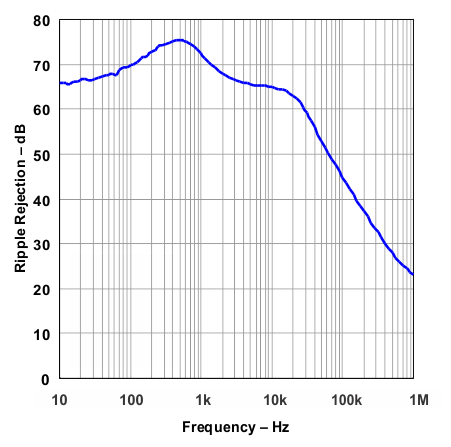
| VIN = 2.7 V | VRIPPLE = 0.05 VPP | IOUT = 750 mA |
| CIN = 0 | COUT = 10 µF (ceramic) | TA = 25 °C |
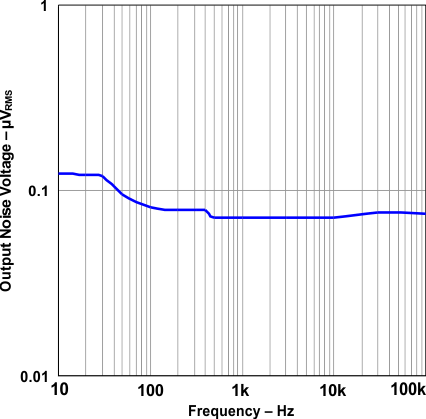
| COUT = 10 µF (ceramic) | IOUT = 1 A | |
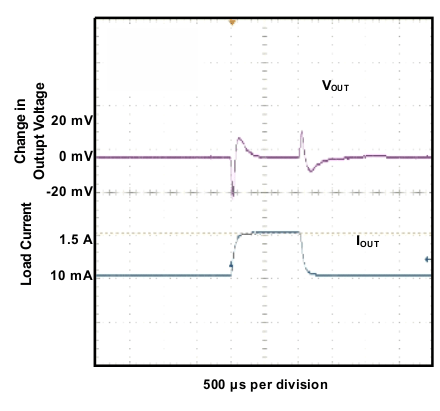
| VIN = 4.3 V | CIN = 10 µF | COUT = 10 µF (ceramic) |